Aegean
The Aegean - that's the sea of the MeItemi north wind and the thousand isIands, Rhodes, the metropoIis of antiquity in the east, Syros (Siros) with a catholic and an orthodox cathedral in the centre, Aegina with the Aphaia Temple in the west, Santorini with its white chapeIs and houses on volcanic rocks high above the blue sea in the south, and Crete - a country rather than an isIand, its mountains two and a haIf thousand metres high, its Minoan culture aImost five thousand years oId. And, last not Ieast, there is the harbour of Piraeus, so busy that the idea emerged to transfer some traffic to Lavrion, east of Cape Sounion, where already Porto Rafti is a competitor. The charm of Piraeus harbour during the steam age is unforgettable, expressed in the 19th century by the works of K.Volonakis and after WWII by Spyros VassiIiou and other painters.

The harbour of Piraeus, by K. Volanakis (contemporary publication)
The Steam Age
After Oesterreichischer Lloyd had opened its Constantinople service in 1837, passengers could change at Syros on a branch line to AIexandria. The first Greek steamship line, EIIiniki & Anatoliki Atmoploiki Etaireia, was founded in Manchester in 1857 and closed down in 1865. The institute of History of Merchantile Marine informed: "The Greek passenger Iines' history has its roots in 1857 in Syros where the Greek Shipping Company was estabIished". The name mentioned in Greek is Elliniki Atmoploia. The report continued: "Up until the beginning of the First World War, another ten companies of the same interest were estabIished". In the 19th century, Messageries Maritimes of France maintained, in addition to the MarseiIles - Piraeus - Constantinople route, branch Iines from Piraeus to Nauplia (Nafplion) on the PeIoponnese, to Syros and to Salonica (Thessaloniki). When that city, at that time still ruled by the Ottoman Empire, got a rail connection with Western Europe in 1888, even the idea of an Indian Mail route by rail and from Salonica by ship to Egypt emerged. In addition to the weII-known companies, steamers of the Prince Line, McDowall & Barbour, Panhellenic SN CO., HelIenic Steamship Line, the New Hellenic SS Co. of Syros and various IocaI lines appeared on the Aegean routes.
After World War I, in 1920, the Western Powers tried to divide up Turkey, which had fought on the side of Germany. Greek shipping to Smyrna (Izmir) and Constantinople boomed. Being defeated in 1922, the tragedy for the Greek living there began, one and a half million refugees arrived in Greece and migration to America or Australia was for many Greek the only way to survive. At that time, more than 50 Greek shipping companies were Iisted, many ones with only one ship. Among the most important enterprises were the NationaI S.N.Co. of Greece (founded in 1908 by the Embiricos brothers), Kavounides (entering this traffic in 1914) and Epirotiki, (started in 1919 by Georgeos Potamianos), Pantaleon, Togyas and other companies. In 1929, AKTEL and in 1939 its successor ELMES became the leading Greek shipping groups.
WWII and Aftermath
World War II decimated the Greek passenger fIeet severely. German troops had invaded Greece in 1941, but Greek fighters blocked the rail connection between these cities in November 1942 by blowing up the Gorgopotamos bridge, thus hampering German war material transport. Mainly Churchill prevented Stalin from participating in the Greek communists' civil war, which lasted until around 1948.
Among the first vessels which restarted Greek shipping, the 1,227-ton "Chimara” had a tragic fate. Built in 1905 as Hertha” in Germany, she was handed over to Greece in 1946 and introduced on the Salonica – Piraeus route. After the "Chimara” left Chalkis, the intermediate port-of-call on 18 January 1947 at 4:10 am, a stroke hit the ship, probably a mine of WWII, the machinery stopped, the ship was thrown on a reef and c.390 people died (among the survivors was an uncle of our brother-in-law, a crew member). It was not before 1951, after the bloody civil war had ended, that the repaired railway could replace the seaway.
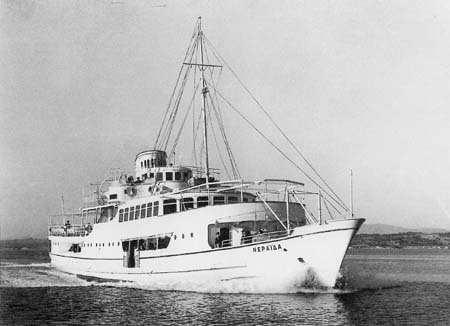 "Neraida", Argosaronic Gulf (coll. O'Georgios)
"Neraida", Argosaronic Gulf (coll. O'Georgios)
Around 1950, A.I. Tzamtzis listed roughly a dozen Greek passenger shipping companies. Among the best known on the domestic market were Epirotiki, Nomikos, Kavounidis and Latsis. The Argosaronic Gulf, where little oldtimers steamed from Piraeus to Spetse, was entered in 1949 by Iannis Latsis with the motor-ship "Neraida”, which later appeared in a movie with Sophia Loren and now was chosen as a museum ship. In the 60s and 70s, Greek migrant workers coming home from Europe to see their families used to take the train and at Piraeus they changed to the numerous shipping lines for their home islands, as deck passengers of course. When in the 60s motor-ships more and more replaced the oldies, the steamers of the TypaIdos brothers were a last relic of the past when they left the harbour bay under a dark cloud of smoke.
Car Ferry Pioneers
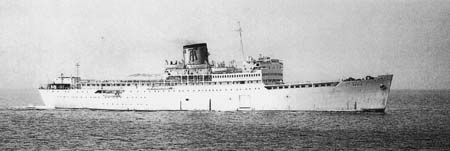
"Hania" of Typaldos, rebuilt as car ferry (source unknown)
|
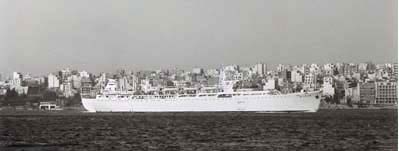
"Kydon" of ANEK, Piraeus 1980 (WS)
|
Kostas Efthymiadis started in 1964 connecting Crete by a 10,000-ton car ferry, the "Phaistos”. Like his "Minos” and "Sophia”, she was a rebuilt Swedish tanker. The ''Heraklion'' (8,922 ts, the former "Leicestershire" of Bibby Line), like sister "Hania” rebuilt for carrying motorcars, was used by Typaldos on the route Piraeus - Crete. She sank in December 1966 and 241 people died. It meant the tragic end of the Typaldos services. Then new companies emerged and finally they replaced the old ones. ANEK introduced in 1970 their first car ferry service from Crete with the "Kydon" (a rebuilt Dutch tanker), in 1989 sold as "City of Taranto”. Minoan Lines started in 1974 from Crete with the "Minos" (a former tanker, too, not to be confused with the "King Minos”), to be followed by the "Ariadne” (the former "Tor Hollandia” of 1967). These two companies from Crete became the main providers of services to that biggest Greek island, competed by other shipping lines. German tourists travelling to Rhodes would have been surprised boarding the former "Deutschland” (II), then "Nisos Rodos” of pioneer Latsis.
Strintzis Lines of a family engaged in the sea traffic already in the 19th century, entered the car ferry business on the Patras – Kefalonia route. Acquired by Attica holding, it changed into a new enterprise, in 2000 labelled Blue Star Ferries. It bought the ships of Dane Sea Lines, which was engaged in the Rhodes traffic. Blue Star Ferries' pride, the 29,415-ton "Blue Star 1” and 2, were transferred from Adriatic to Rhodes services. Blue Star, together with Superfast (via Attica holding) was acquired by the Marfin Investment Group (MIG), in which the Dubai Group has a substantial share. The Attica Group became one of the main players on Aegean (and Adriatic) routes.
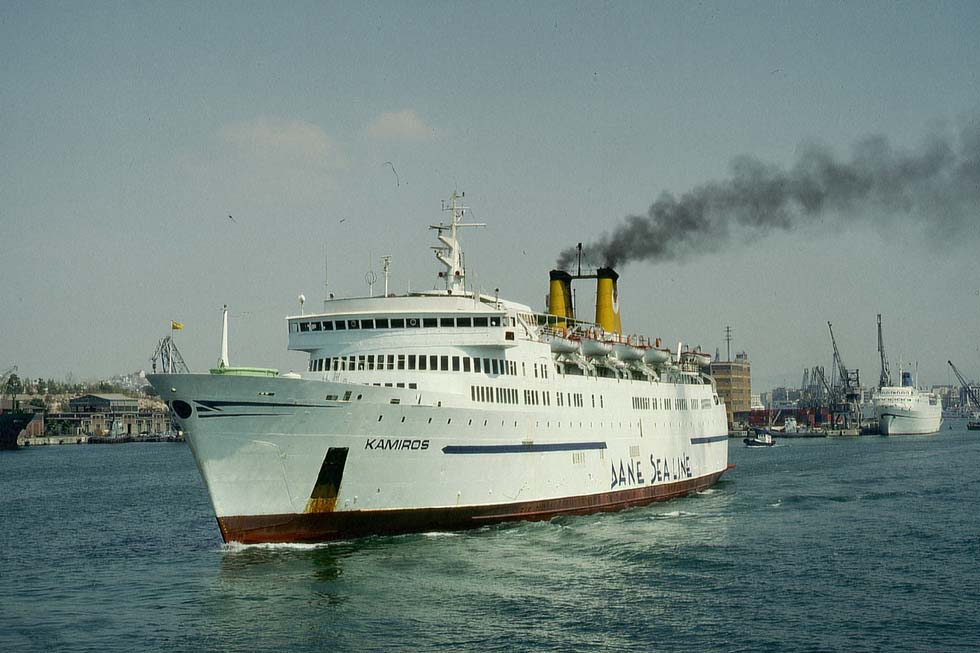
"Kamiros" of Dane Sea Lines, the former "Prins Hamlet" of 1966, Piraeus 1994 (WS)
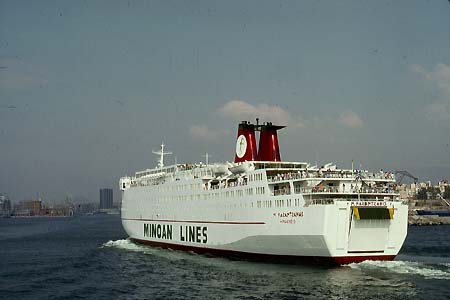
"N. Kazantzakis" of Minoan, Piraeus 1990 (WS)
|
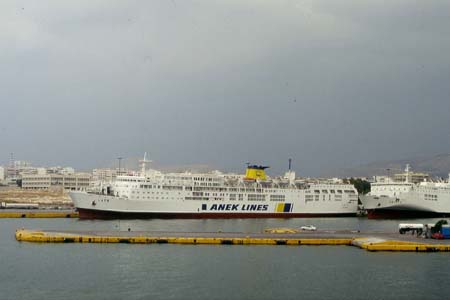
"Lato", ex "Daisetsu", "Varuna" (of Higashi Nippon), Piraeus 2002 (WS)
|
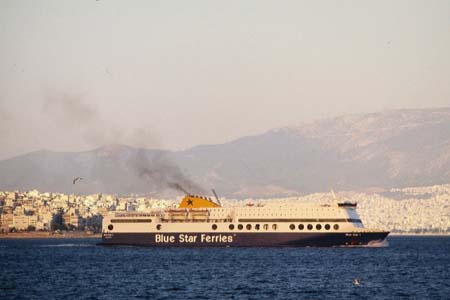
"Blue Star 1", departure Piraeus, 2009 (WS)
|
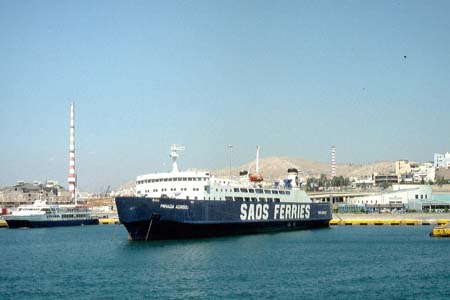
"Panagia Agiassou", ex "Hankyu No.17", "Ferry Kampu", "Ferry Pukwan", "Eun Ha" (of the Busan route), Piraeus 2008 (WS)
|
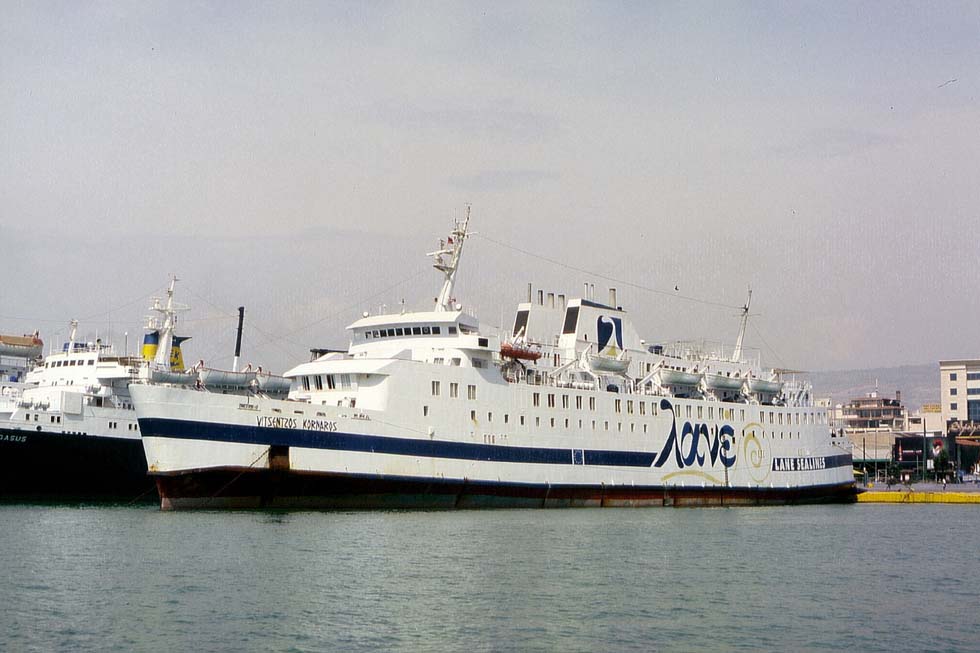
"Vitsenzos Kornaros" of Lane (built for Townsend Thoresen?), Piraeus 2008 (WS)
Newcomers
"In early 1988 nobody did know Gerasimos Agoudimos among the ship-owners of that time. The tradition was kept on by the families of Ventouris, Agapitos and the Cretan joint-stock companies ANEK and Minoan Lines...”, wrote the daily To Vima (27 Sept. 2009). Agoudimos started GA Ferries, concentrating on lonely routes, subsidized by the government. In 2008 the subsidies faded and one year later the aged GA fleet was in the hands of creditors. Thanks to another company, LANE Sea Lines, founded by a lady from Crete and then 50% owned by ANEK, even the remotest island Kastelorizon in the east, during years not reached by any car ferry, got a subsidized Iink with Piraeus. SAOS Ferry, which achieved a substantial yield with subsidized services, was criticized by the ship-owners' association and its chairman Apostolos Ventouris, owner of NEL Lines. In 2009 the old SAOS ships were laid up. Small newcomers, not listed here, are a different matter.
Foundation of HSW
Old ships of a multitude of enterprises had caused criticism concerning safety lacks. Unrealistic EU safety rules of 1998 would have requested the withdrawal of half of the c.120 ferries used on Greek island services (according to the German magazine GEO Special 3/2002). The report criticized the fire accident aboard the "Superfast III" on the Adriatic route in 1999 without mentioning that she was a completely new ship, built in Germany. "Naval battle for Greek ferries” was a headline of a Greek paper in 2009, when a German automobile club had criticized Greek vessels. Testers did ‘forget' that in the Baltic Sea even after the "Estonia” catastrophe bow-doors were in use, while in Greek waters they disappeared from longer routes.
Facing the EU's "open market" policy, amalgamation of various Greek shipping services into one bigger company appeared necessary. The idea was carried through by Pantelis Sfinias of Minoan Lines, supported by the government. The new company emerged out of the acquisition of the "Flying Dolphins", the car-carrying catamarans ''Highspeed 1" to 4 and four "Flying Cats" of Minoan Lines under various brand names. Despite the catastrophe of their ferry 'Express Samina", which stranded at Paros Island in 2000, kiIIing 80 passengers while the captain and the officers enjoyed a football television, the concept survived - but P. Sfinias died in a tragic way, jumping off the window of his office. In 2005 Hellas Flying Dolphins, parent of Hellas Ferries, decided to adopt the name Hellenic Seaways, abbreviated HSW.
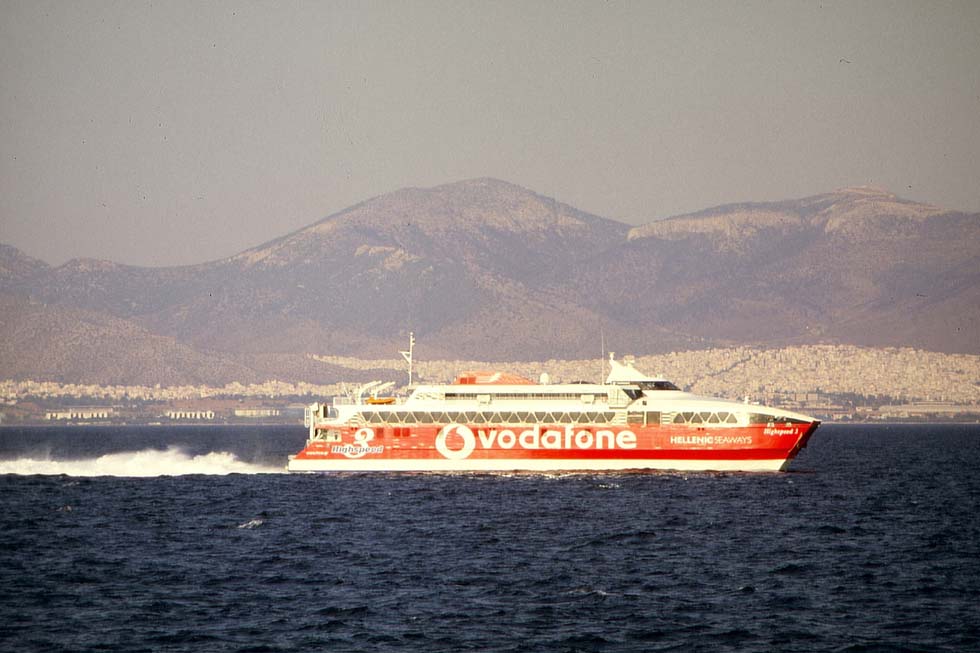
"High Speed 3" of HSW, after departure from Piraeus, 2009 (WS)
Hi-Speed
A new age of Aegean shipping had started with the first hi-speeds. A pioneer was the "Express”, which appeared on an Argosaronic route already in the 60s. Services multiplied when Ceres, a subsidiary of Nomikos Lines, successfully introduced the yellow/blue "Flying Dolphins", small hydrofoils for a speed up to 34 knots with 116 bus seats, resembling the Russian "Kometa” type, built at Poti in the USSR from 1976 on. As they were designed for inland shipping, they could run from Piraeus only across the Argosaronic Gulf, the region with the highest passenger numbers, and from Evia to the Northern Sporades. Smaller companies introduced "Flyings", too. There was also a test with a tiny hovercraft, unsuitable however, and the introduction of the first catamarans. Novoship, Strintzis Lines and Agapitos Lines were among the pioneers. One of the oldest monohull hi-speeds, introduced by GA Ferries as "Jet Ferry 1”, was the former "Kattegat” of 1995, sister of P&O's "Jetliner”, laid up in 2008, arrested.
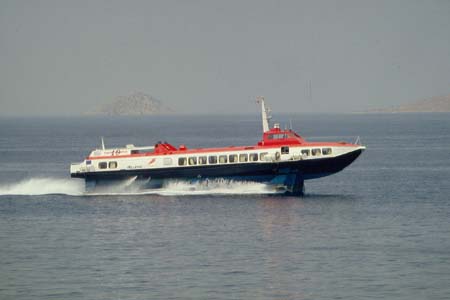
"Flying Dolphin 19" of HSW, Argosaronic Gulf, 2006 (WS)
|
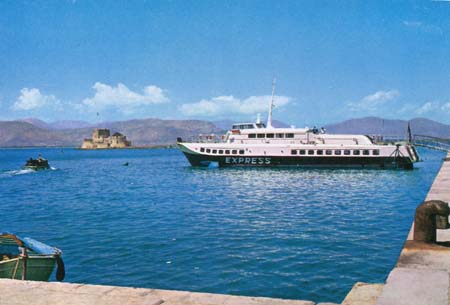
"Express" at Nafplion (old card)
|
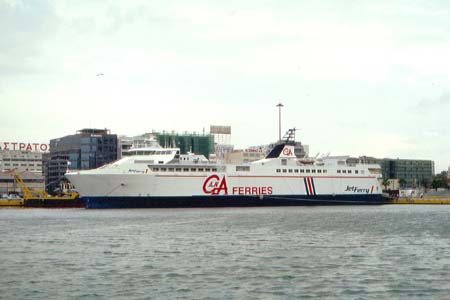
"Jet Ferry 1" of GA Ferries, the former "Kattegat", Piraeus 2006 (WS)
|

"Sea Speed 1" of Agapitos Lines, Piraeus 1999 (WS)
|
On the important route Piraeus - Heraklion, Crete, the timetable of 2006 showed the conventional fast ferries with 6 1/4 hours travelling time, while the Austal-built catamaran "Highspeed 5” of HSW covered the distance of 174 nm in 4 1/2 hours. In 2009 HSW added to their catamaran-type hi-speed fleet a Fincantieri MDV1200-type monohull, the former "SuperSeaCat Two, then "Viking”, renamed "Hellenic Wind”. In 2010 a sell to Arabian owners was stated, but in late 2011 the "Hellenic Wind” could have been watched at Perama in Greece, sporting the label of Atlanticolines, the company of the Azores, which had leased the gas-guzzler. Two inherited catamarans were replaced in 2010 by the InCat 96-m "Highspeed 6”, the former "Milenium” of Acciona Trasmediterranea, introduced on Aegean island services.
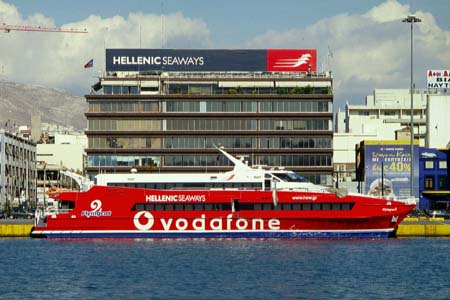
"Flyingcat 2" of HSW, Piraeus 2007 (WS)
|
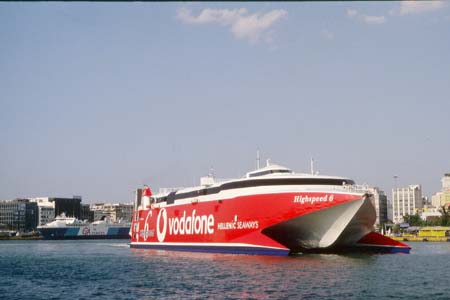
"Highspeed 6" of HSW, Piraeus 2010 (WS)
|
NEL Lines introduced blue/white monohull hi-speeds resembling the Corsaire types of SNCM, the ''Aeolos Express" (2000/ 3,536 gt), ''Aeolos Express II" (2001/ 5,364 gt) and ''Aeolos Kenteris" (2001/ 11,705 gt, 40 knots, 442 cars). The red/white "Panagia Parou" and "Panagia Thalassini" (1996/ 4,934 gt each) of associated C Link were acquired in 2005 from SNCM. Owner Apostolos Ventouris fought successfully for a compensation by French producers for engine failures of the monohulls and acquired the NEL share held by ANEK. The "Panagia Parou” and ''Aeolos Kenteris" were temporarily repositioned to the Red Sea (see chapter Arabia) and later even the intention of an engagement in the Black Sea was rumoured. In 2010 the "Aeolos Kenteris I” was temporarily chartered out to SNCM of France. The blue/white hi-speed fleet of NEL Lines in the Aegean was joined in 2010 by more economic catamarans, the "Cyclades Express” being the InCat 028 of 1992, the former "SeaCat Scotland”. The "Alkioni”, a Japanese heritage, was introduced on services from Thessaloniki.
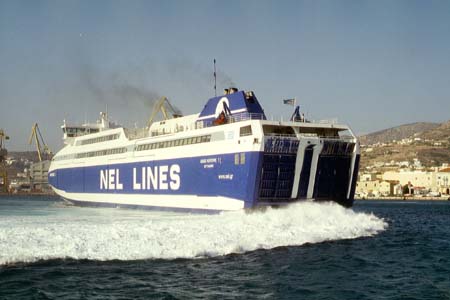
"Aeolos Kenteris I", turning at Syros 2008 (WS)
|
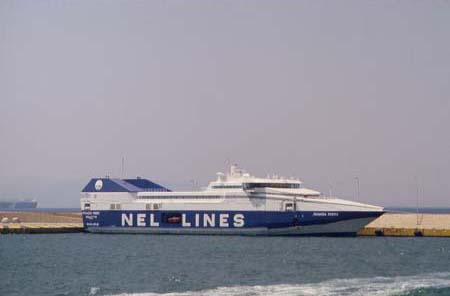
"Panagia Parou", Piraeus, Oct. 2010 (WS)
|
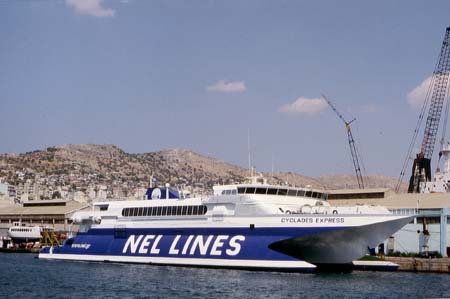
"Cyclades Express", ex "SeaCat Scotland", Perama 2010 (WS)
|
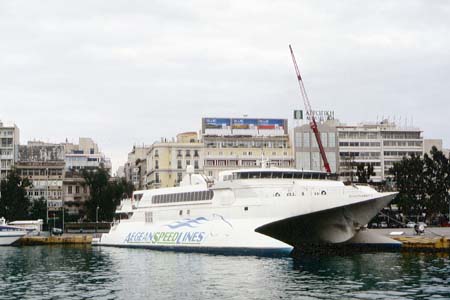
"Speedrunner I", the former "Hoverspeed Great Britain", Piraeus 2006 (WS)
|
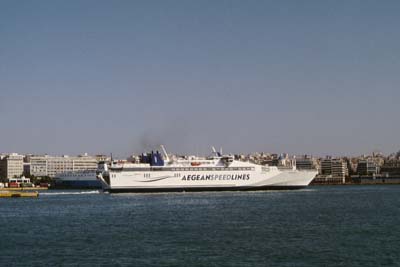
"Speedrunner IV", ex "SuperSeaCat Four", Piraeus 2009 (WS)
|
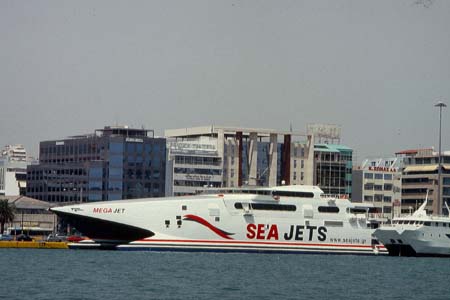
"Mega Jet", ex "Cat-Link I", "Thundercat 1", "El Tarifa Jet", Piraeus 2008 (WS)
|
The first operator to enter the Greek market under the new EU rules of liberalization appeared with the spectacular "Speedrunner I", a catamaran built by InCat in 1990 as the famous "Hoverspeed Great Britain" for Channel services of Hoverspeed, owned by the Sea Containers Group of James Sherwood. From 2005 she connected Piraeus with Aegean islands in a joint venture with the Eugenides Group, sporting the label Aegean Speed Lines. Later this historic boat operated temporarily for Alpha Ferries as "Sea Runner”. Aegean Speed Lines introduced in 2007 by the "Speedrunner II”, the former "Pegasus One” of the MDV1200 monohull type from Fincantieri. It is the family of famous shipping pioneer Eugenides, founder of Home Lines around six decades ago, who became the full owner of Aegean Speed Lines. In 2009 also the monohulls "SuperSeaCat Three” and Four of the extended MDV1200-type were transferred from the Baltic to Cyclades services, renamed "Speedrunner III” and "Speedrunner IV”. The former "Hoverspeed Great Britain” however changed colours in 2010 and appeared temporarily as "Searunner” on one-day Santorini cruises for a touristic enterprise.
Profiting from the EU rules of market liberalization, the yellow/white monohull "Corsica Express Three" of Corsica & Sardinia Ferries' subsidiary Kallisti Ferries entered in 2007 the Piraeus - Samos service. In 2009 however, the Italian-owned company abandoned the Greek ferry market.
In 2008 the "MegaJet" of SeaJets appeared as an eyecatcher on the Santorini and Crete route. It is an InCat-built catamaran of 1995 (ex "Cat-Link I”, "Thundercat I”, "Tarifa Jet” of FRS Iberia). SeaJets was built up by the Cypriot Stelios Haji-Ioannou, the well-known pioneer of easyJet airline.
Gambling...
After Hellenic Seaways or HSW was founded, Minoan confirmed to hold a 33% stake in HSW. GA Ferries of Agoudimos had left the venture already before and Strintzis Lines had been sold, while G. Strintzis became chief manager of HSW. According to Ta Nea of July 22, 2006, the biggest stake in HSW was held by Panos Laskaridis and by Minoan Lines and a minor one by Apostolos Ventouris. Then P. Laskaridis bought an additional share, previously held by K. Agapitos of NEL, but finally he concentrated on his cargo business.
In Oct. 2006, Ta Nea supposed: "Simultaneously with the gambling for control of HSW, also ANEK tries to enter, rising the number of applicants to three". In 2007 ANEK repositioned for one season the fast car ferry ''Hellenic Spirit" from the Adriatic to the Piraeus – Chania route. It competed with Minoan Lines' "Festos Palace", "Knossos Palace" (37,482 gt each) and the smaller "Ariadne” (1996/ 13,597 gt, ex "Rainbow Bell" of Kyuetsu Ferry, then "Ferry Hinuka"), acquired by HSW for the Piraeus - Heraklion run. In 2008 ANEK under CEO Yannis S. Vardinoyannis of a family engaged in the Aramco oil industry acquired the ex-"Sun Flower Tsukuba” (1998/ 12,325 gt, of Blue Highway, then Shosen Mitsui Ferry) and rebuilt her splendidly as "Elyros” for Crete services. "Ariadne” changed its red HSW funnel paint to ANEK's yellow. The "Nissos Rodos” of HSW (1987/ 13,608 gt, ex "Kiso” of Taiheyo Ferry of Japan, "Ocean Trailer” of HSW, "Hellenic Voyager”) entered in 2010 the Rhodes service. With a 37% stake in Sea Star Capital Plc, holding a decisive share in HSW, Vardinoyannis had become the latter's main player, then joined by cargo shipping entrepreneur Victor Restis.
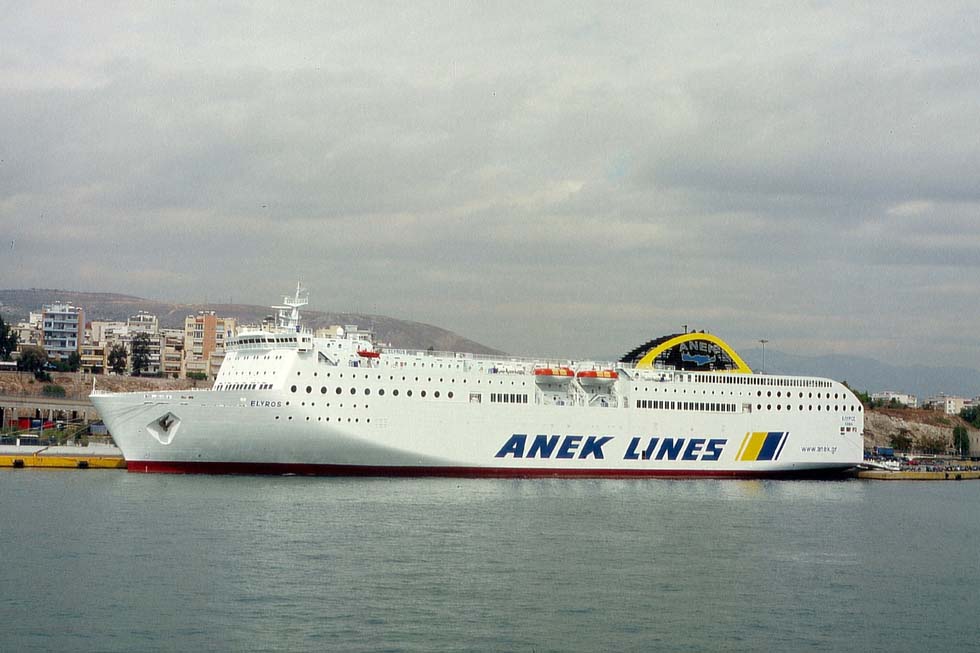
"Elyros", ex "Sun Flower Tsukuba", Piraeus 2008 (WS)
On the heavily combated Crete route appeared in 2009 also Superfast Ferries of the Attica Group. They relocated the 30,902-ton "Superfast XII” from the stagnating Adriatic market to a daily fast service Piraeus – Heraklion.
Concerning Minoan Lines, Lloyds List reported in late 2008 a 85% share owned by the Grimaldi Compagnia di Navigazione SpA. Ta Nea (28 June 2008) informed that it "is intending to concentrate on long Mediterranean routes and to leave the Cyclades services to Hellenic Seaways". The report was published under the headline: "The poker for HSW.” For long Minoan routes, Emanuele Grimaldi anticipated new ferries with 3,000 to 4,000 lane metres.
When in 2010 the Greek government started to reduce the national debt in order to remain in the euro zone and labour unions reacted with strikes, the port of Piraeus seemed to be as busy as before, but Lloyd's List reported heavy losses in the ferry business. A closer cooperation of Sea Star with the MIG-owned Attika Group under Andreas Vienopoulos was decided and e.g. in 2011 the important Piraeus – Heraklion route was operated with the "Olympic Champion” and "Superfast XII".
|